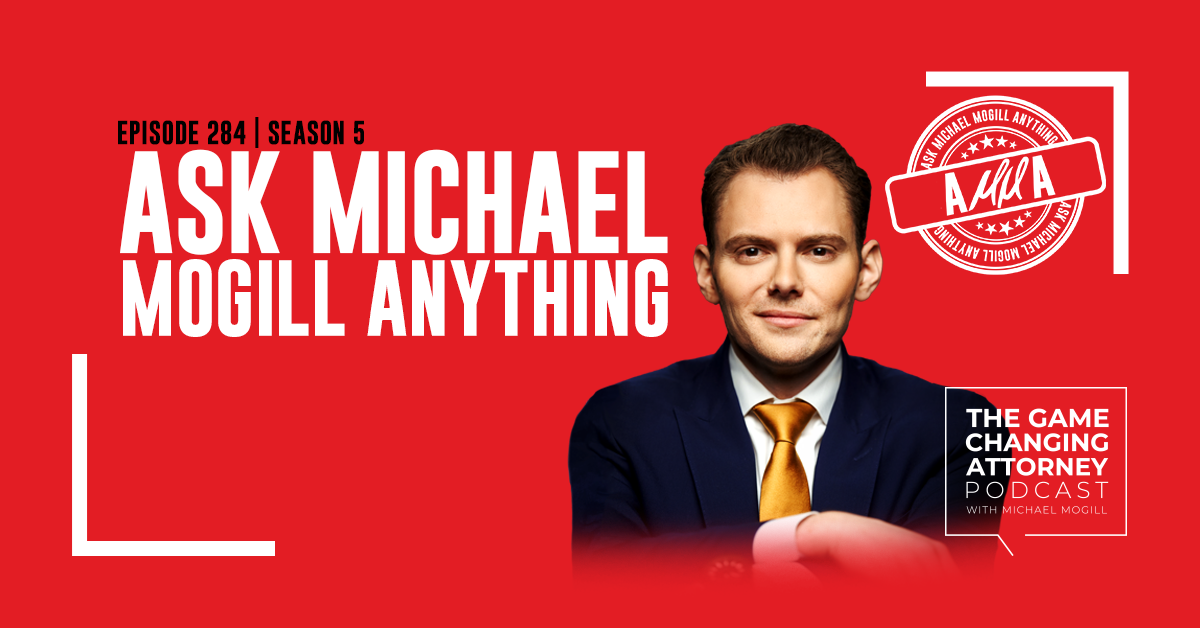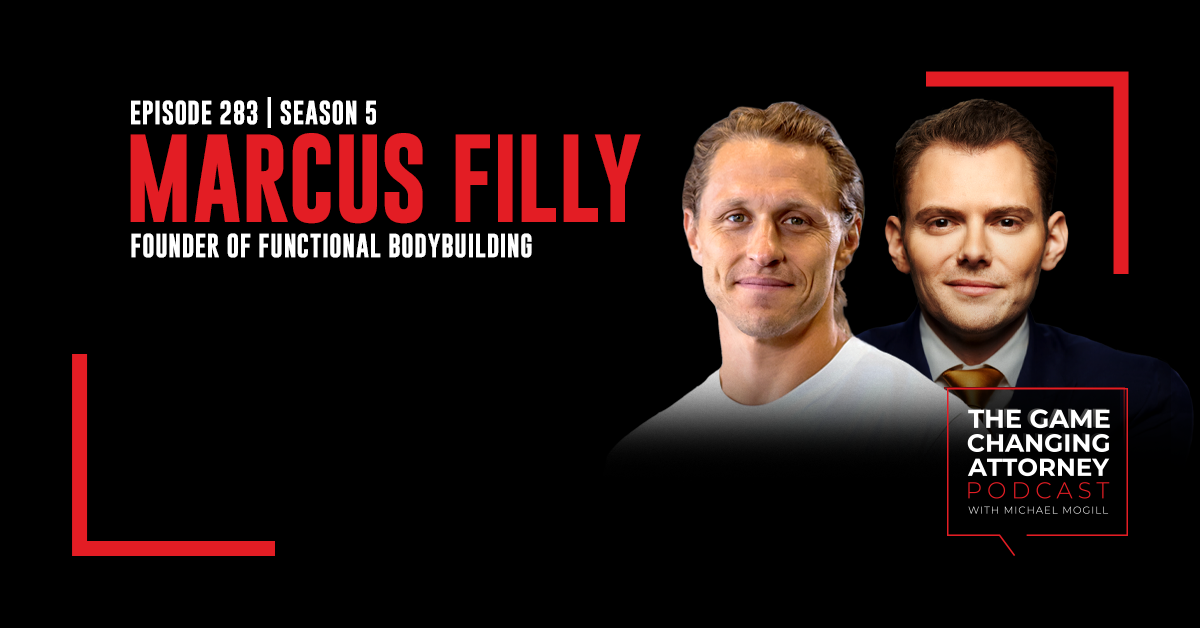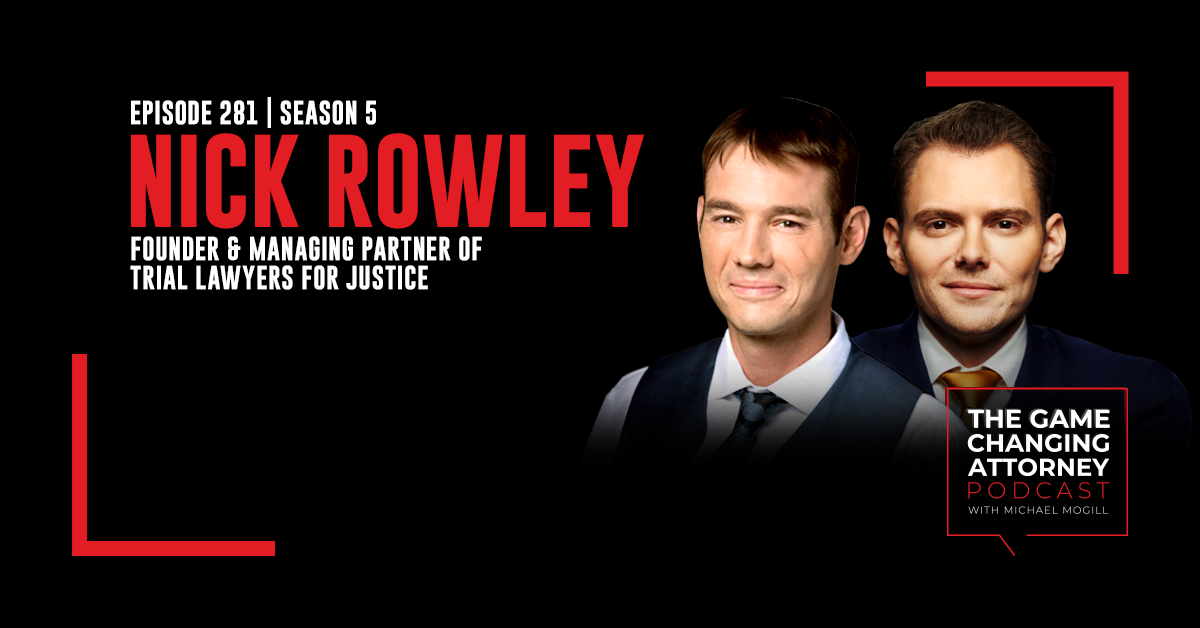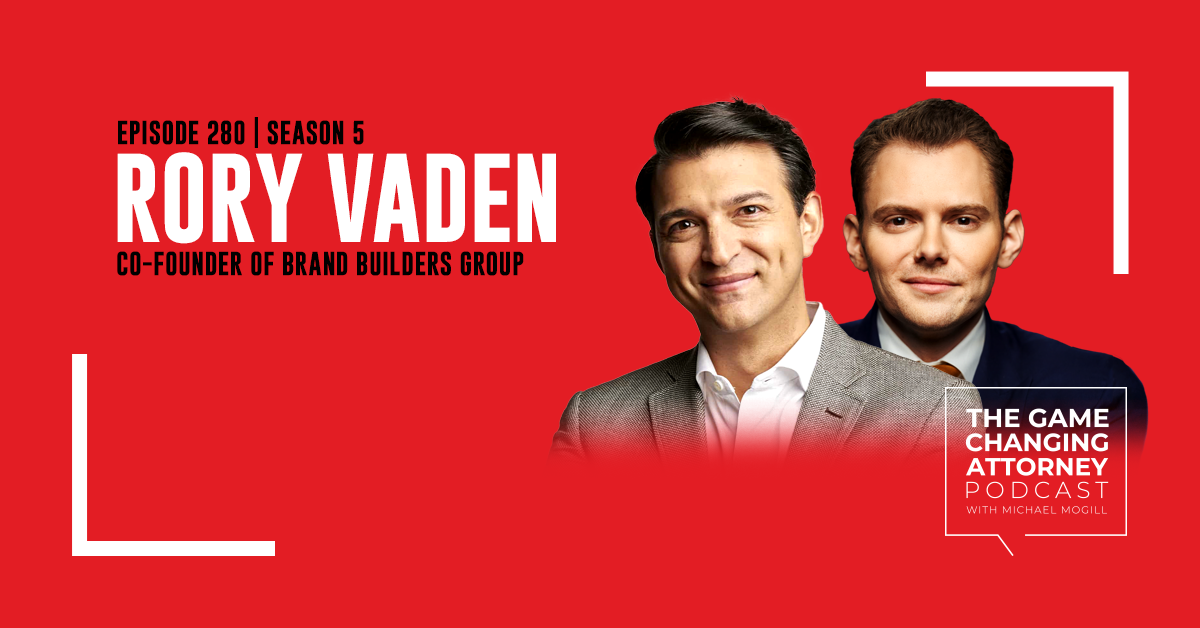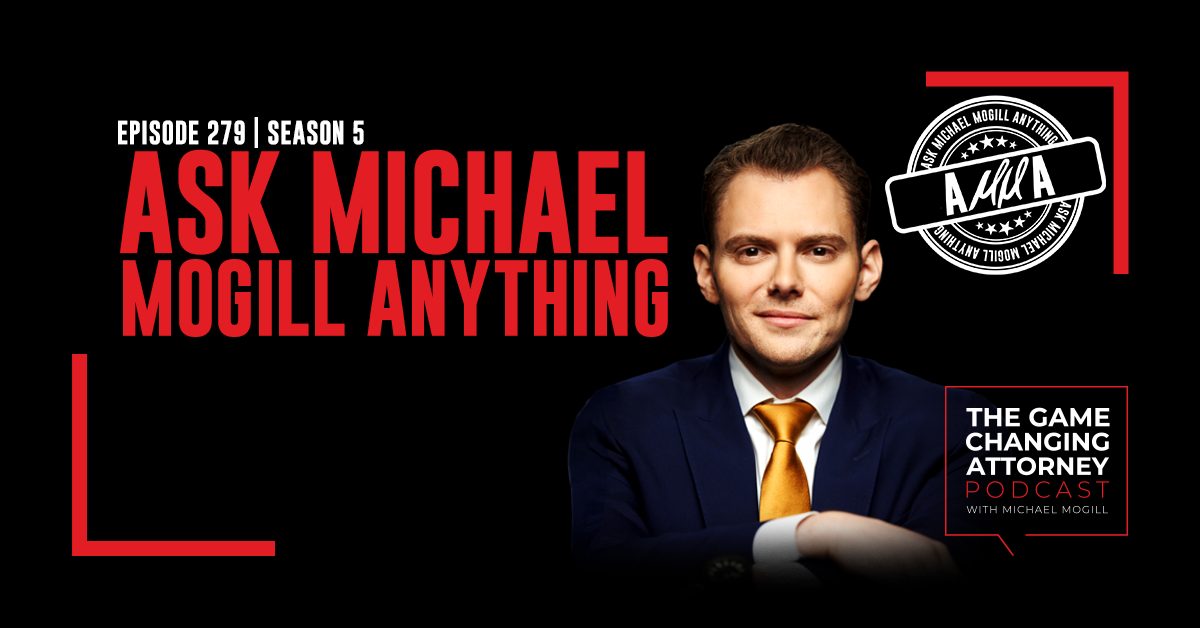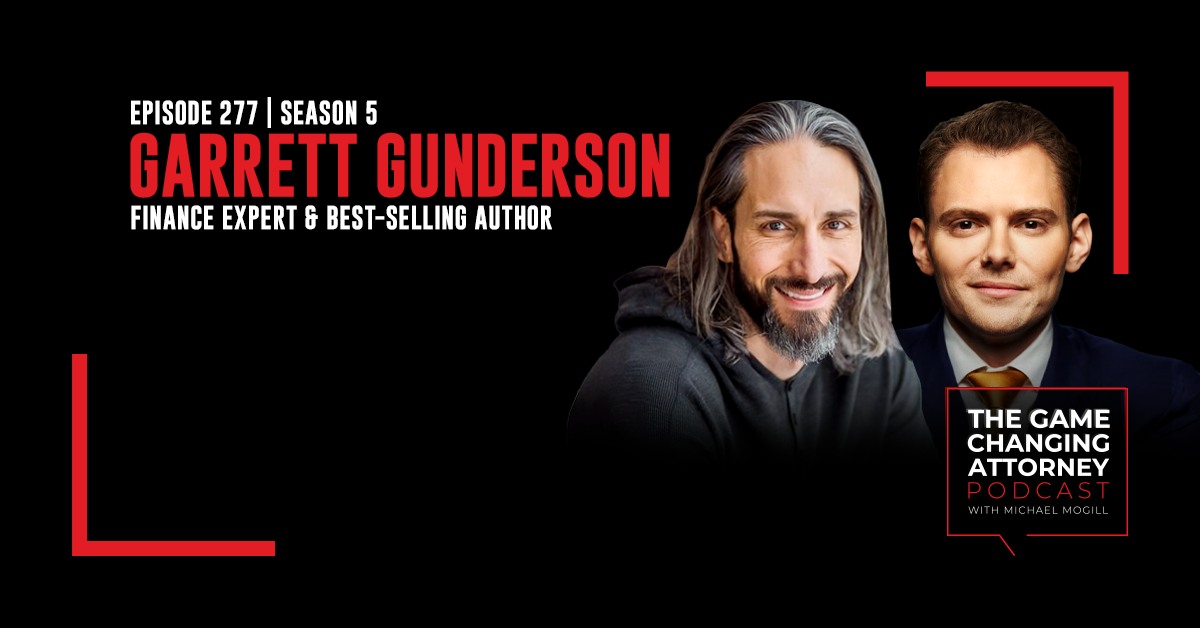
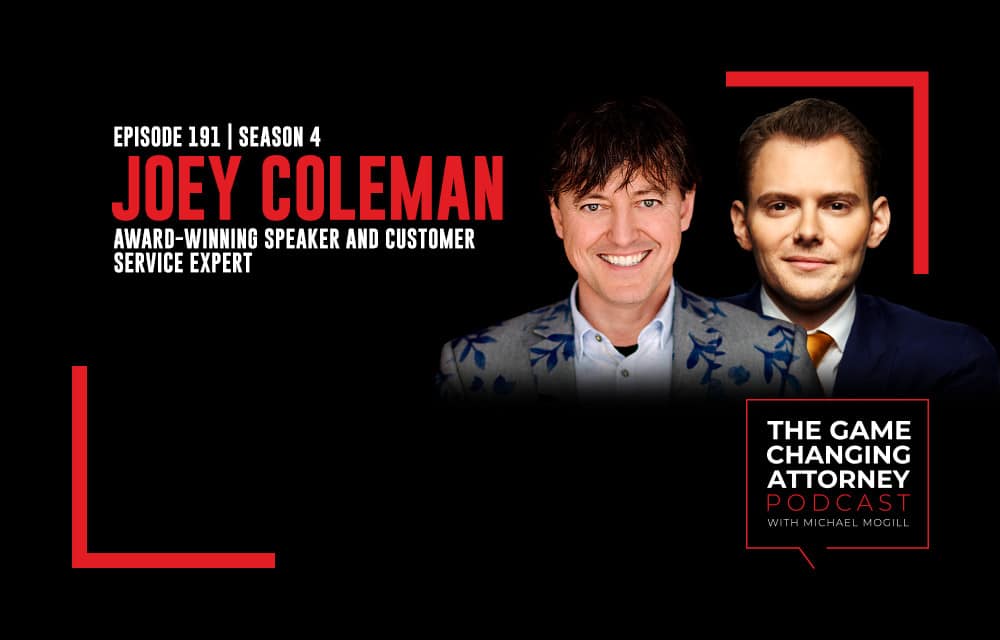
Episode 191 — Joey Coleman — Never Lose an Employee Again: The Simple Path to Remarkable Retention
For nearly 20 years, Joey Coleman has helped organizations retain their best customers and employees, turning them into raving fans via his entertaining and actionable keynotes, workshops, and consulting projects.
His latest work focuses on helping organizations recruit top talent, bring A-players on board successfully, and keep them engaged while they produce remarkable results for years to come.
Now, he’s helping you do the same in your law firm.
In this episode of The Game Changing Attorney Podcast, Joey and Crisp Founder & CEO Michael Mogill explore:
- A step-by-step process to maximizing your employee retention
- Why giving new hires “orientation” is NOT enough
- The crucial difference between coworkers and colleagues
- And so much more
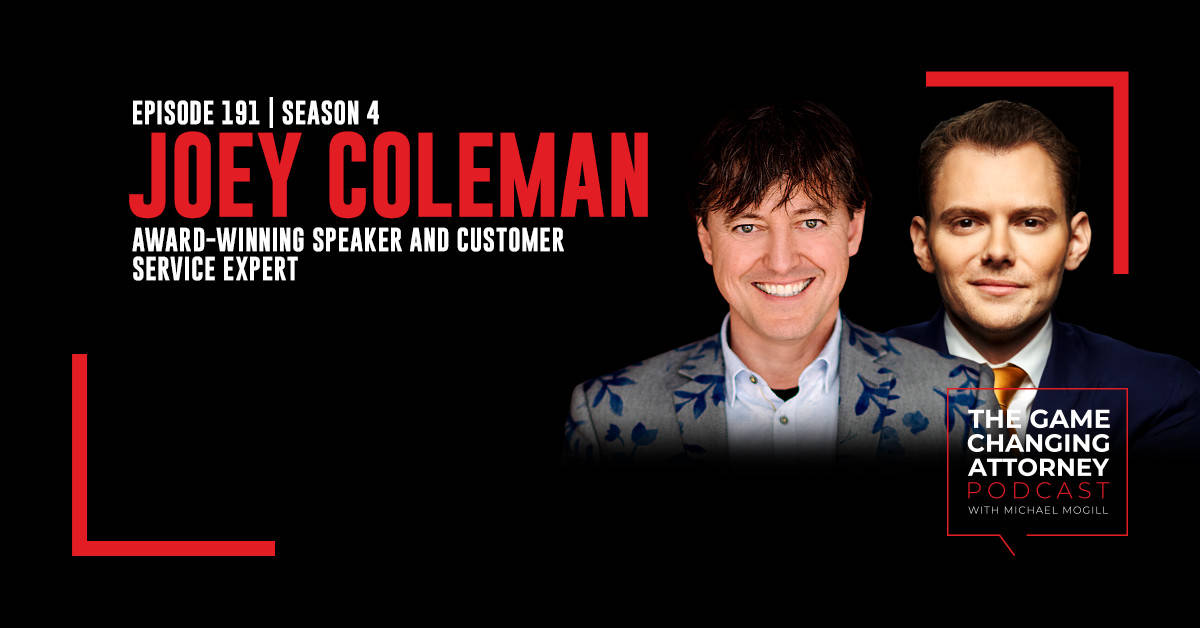
Listen & Subscribe
Show Notes:
Client experience and employee experience are connected. “I’ve been doing customer experience for about 20 years now, and I was about five minutes into that career when I realized that you can’t have a great customer experience unless you have great employees to deliver that experience. I think the challenge is in most organizations, customer experience and employee experience are very siloed activities. Usually customer experience is the purview of marketing and sales and maybe account support services, whereas employee experience has a tendency to sit over in a silo of HR human resources, and very rarely do those conversations interact.”
Onboarding vs. orientation. “When someone leaves, there’s any number of reasons why they might say they’re leaving. But when they leave quickly, that seems to indicate that something went wrong fast. What that usually is is that most businesses are focused on orientation instead of onboarding. Orientation is things like, ‘This is when you need to be at work, and this is where we have lunch, and this is where the bathrooms are, and by the way, if there’s a fire, here’s the alarm.’ Interestingly enough, those are the same kind of things you would learn if you went on a cruise, right. They’re going to tell you, ‘Here’s where you get your food. Here’s the bathrooms. Here’s what we do in case of a fire.’ That’s not onboarding. Onboarding is a more methodological approach. It’s a more systemic approach that says, ‘What can we do to make someone feel like they’re part of the team, that they understand that they’re part of something bigger than themselves?”
Buyer’s remorse applies to new hires too. “The scientifically proven fact is that immediately after accepting a job offer, a new employee begins to doubt the decision they just made. I mean, it literally happens in the seconds after they sign their offer letter. Why is this? Well, a couple of things happen. Number one, the dopamine release that comes with getting the offer, that excitement, that joy, that euphoria starts to fade along with the dopamine receding from the brain, and now they feel fear and doubt and uncertainty about the choice they just made. ‘Should I have negotiated for a better deal? They said this is all they could offer and these are the usual benefits, but if I would have pushed more, could I have gotten more?’ It’s also the case that top talent is probably interviewing at a lot of different places at the same time. And so when they accept your job offer, there are probably outstanding interviews they’ve done that haven’t resulted in an offer yet, and they’re wondering, ‘Well, if I wait a little longer, is that the one that would have been the better thing?’ That fear and doubt and uncertainty that they’re feeling is usually matched by what from the employer? Oh, that’d be very little communication. We’ve said, ‘Hey, we’ve got the job offer. Great. We want you to start three weeks from now on Wednesday.’ There’s no other communication happening. So in that Affirm stage, we need to affirm their choice to work with us.”
What about the second day on the job? “In almost every organization on the planet, there’s someone who’s responsible for the first day on the job. When I go to those same organizations and I say, ‘Great, who’s responsible for the second day on the job?’ It’s like cue the tumbleweeds and crickets. No one’s responsible for that. So what are you doing to help acclimate those folks to this new role, their responsibilities, the relationships they’re going to have in the organization, and how are we building that over time instead of trying to fire-hose them all in the first day?”
Don’t burn bridges with departing employees. “Advocates aren’t just limited to your W2 employees. Advocates can be anyone who ever worked for your organization. The best thing you can do as an employer is to make your offboarding when an employee leaves as remarkable as the onboarding was when they came in. For so many employers, it’s like, ‘Oh, you’re leaving. Let me throw a match and burn that bridge. You’re dead to me. I never want to talk to you again.’ And it’s like, why not have that person as an advocate in the marketplace who when asked, ‘Hey, where’s a great place to work?’ or ‘I’m thinking about applying at this place,’ they go, ‘Oh my gosh, that was the best place I ever worked. They’re amazing there. You should totally apply.’?”
How employee retention impacts your bottom line. “Research that was commissioned by Glassdoor shows that for employees who have a strong onboarding experience (so we get that first 100 days right and they feel connected to the organization), it’s an 80% increase in productivity and a 70% increase in retention. I don’t know about you, Michael, but I don’t want to just be the guy who’s like, ‘Oh, love on your people, treat your employees well, that’s great,’ but the CFO, the bean counter in your office, is saying, ‘Well show me the money, Joey. Where does this lead?’ It leads to less money being spent on hiring new people. Because to me, one of the most shocking statistics in the book is that the cost of hiring a new employee is somewhere between 100% and 300% of that employee’s annual salary. This is real money. This isn’t just all about emotions and feelings. Yes, that’s part of it, but it’s about your bottom line as well.”
How to stand out to job seekers. “My favorite thing to do in job postings is to figure out a way to bring forward the experience of what it’s going to be like to work there. So many job postings, if I were to go to the typical company’s website or their indeed or LinkedIn page where they have their job listing, and I was to pull that and I was to erase their logo and name and replace it with any of their competitors, no one would be able to tell the difference. So the first thing we need to do is make our job postings about our organization and really let our brand spirit shine through. Now that doesn’t mean you go on and on about who you are as a company. What you should do is go on and on about what it’s like to be an employee. Have quotes from existing employees. Have testimonials from people who are currently in the job. You’re looking for real names — real people talking about their experience. Some of the most innovative companies I’ve seen are doing things like creating a page on their website where for every position they have videos and testimonials from people in that current role talking about what a day in the life looks like. Imagine applying for a job and going, ‘Gosh, I wonder what it would be like to be an Account Manager at Acme Corp,’ and you go to the Acme Corp careers page and you can see interviews with their 10 current Account Managers talking about how great it is to work there, what they love about their job, what they love about their boss, what they love about their career and their path forward. Now you’re having a completely different conversation.”
Great people can go anywhere. Why would they choose you? “Here’s the thing. You start to realize that great people really have a lot of options. I mean, they can go anywhere. Let’s say, for the law firms that are listening, they want great trial lawyers. Great trial lawyers can really go to any law firm. I mean, they would love to have them. So why would they be attracted specifically to your law firm? And what kind of energy and effort are you putting into — you know, ‘recruit’ is an interesting word. I like ‘attract.’ You know, because so much of it is just in the marketing and the sales of getting those types of people interested in your organization, defining the values of that organization. It’s difficult to stand out. You’ve got a ton of competition. I mean, it really is like college football.”
Think of them as your team, not your employees. “What’s interesting is I’m a big believer of thinking about the people who you work with as your team, not your employees. No one wakes up in the morning and says, ‘I’m excited to be an employee.’ Frankly, no one wakes up and says, ‘I’m excited to be an employer.’ But what people do get excited about is being part of a team, being part of something bigger than themselves, and the way we think about that first day on the job, you can create a feeling of team by shamelessly stealing from things that teams do to build cohesion, to build connection, to build collaboration. Aren’t these all the things we want our employees to experience? I certainly think so.”
Coworkers and colleagues are not the same thing. “I like to think of them as two very distinct types of relationships. A coworker is someone who works for the same organization. They get a check from the same company. So they may be a coworker in an office space, or they may be a coworker remotely. It’s just someone else who when they say who they work for answers the same way you do. A colleague is a friend. A colleague is someone who, when you come in on Monday, doesn’t say, ‘What’d you do this weekend?’ They say, ‘How did the game go? How did the recital go? How’s that lawn looking?’ They know what you were planning to do for that weekend, because they talked to you about it last Friday. It’s really easy to quit coworkers. It’s very hard to quit colleagues. It’s very hard to give your notice when you have a bunch of colleagues.”
Boomerang employees who come back after leaving. “You’re going to have employees that for whatever reason leave. Often those are for things that are beyond our control. Their spouse or significant other gets a promotion or job in another city, and you don’t have an office in that city, and you don’t allow remote work, so now they leave. Or they have a parent that gets ill, and they need to move to be closer to that parent to take care of them, or a child, or some situation happens that’s well beyond your control. This is why, as I was saying earlier, it’s so important to maintain those alumni connections, because if they were great when they worked for you the first time, don’t you think they’ll be even better the second time? They already know the ropes, they know the game, they know how it works, and they’ve acquired new skills and new perspective and new insight wherever they worked in that interim period. I love the idea of team members of mine going out, having great life experiences, maybe even different work experiences, and then bringing those learnings back to the fold. And if you have a culture of a gratitude and a culture of appreciation and a culture of innovation that is accepting of those boomerang employees, now you are able to advance and accelerate in ways that you’ll never be able to do just with your in-house team.”
What does being a game changer mean to you? “To me, being a game changer means a number of things, but one that I’ll focus on is constantly being willing to say, ‘How can we do this better? How can we think differently? How can we show our feelings differently? How can we interact with our clients, our employees, our colleagues, our coworkers, our families, our friends differently?’ If you want to change the rules of the game, if you want to play at the highest level, you have to be willing to look at what you’re doing and say, ‘How can I make it better?’ Not only how can we make it better and the firm make it better, but where are the areas where I can change the game in my own life that will make me show up in an even better way for the people I serve?”
RESOURCES & REFERENCES
Never Lose a Customer Again by Joey Coleman
Never Lose an Employee Again by Joey Coleman
Jim Kwik
Bonnie Raitt
Glassdoor
W2 employees
LinkedIn
Tribute
Andrew Horn
The Wizard of Oz
University of Notre Dame
University of Georgia (UGA)
Nick Saban
University of Alabama
University of Southern California (USC)
NFL
MLS
JAM
Netflix
Lego
Zoom
Yoko Co
Bonusly
Connect with Michael
- Text directly at 404-531-7691
